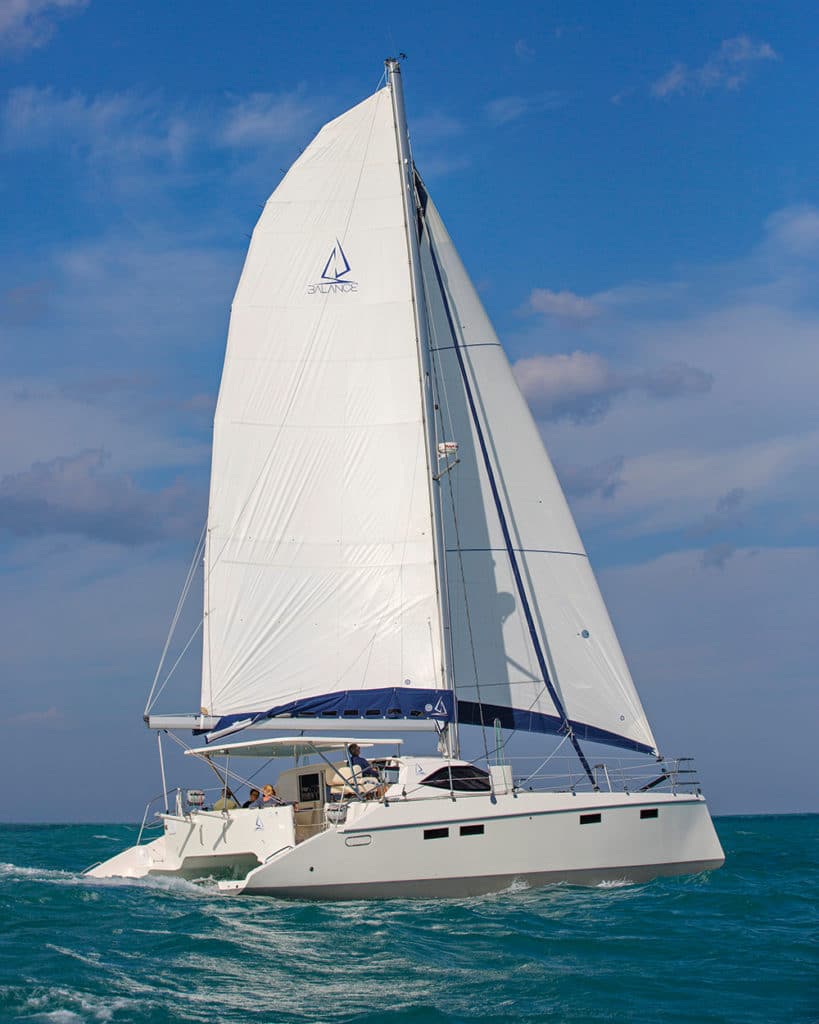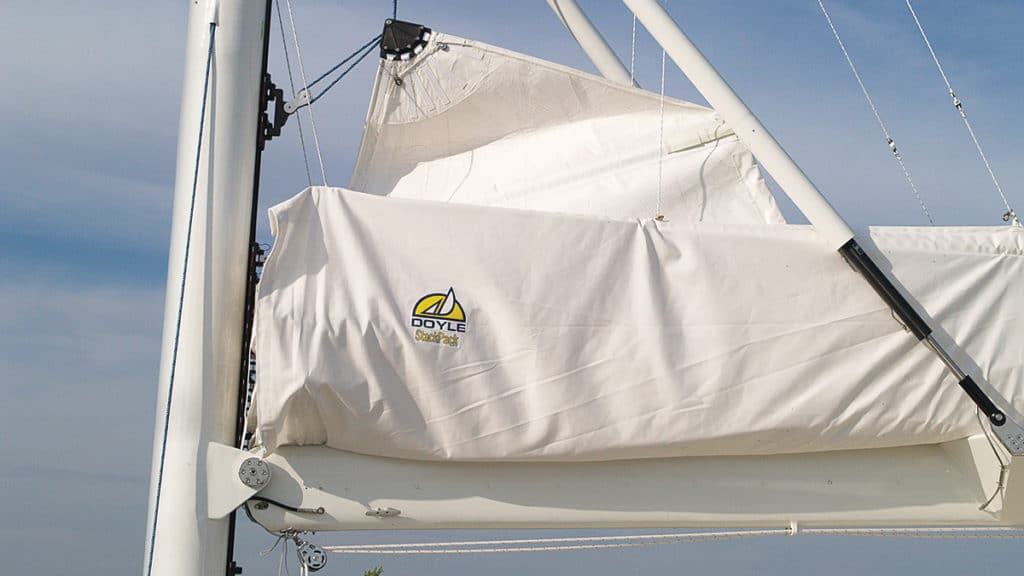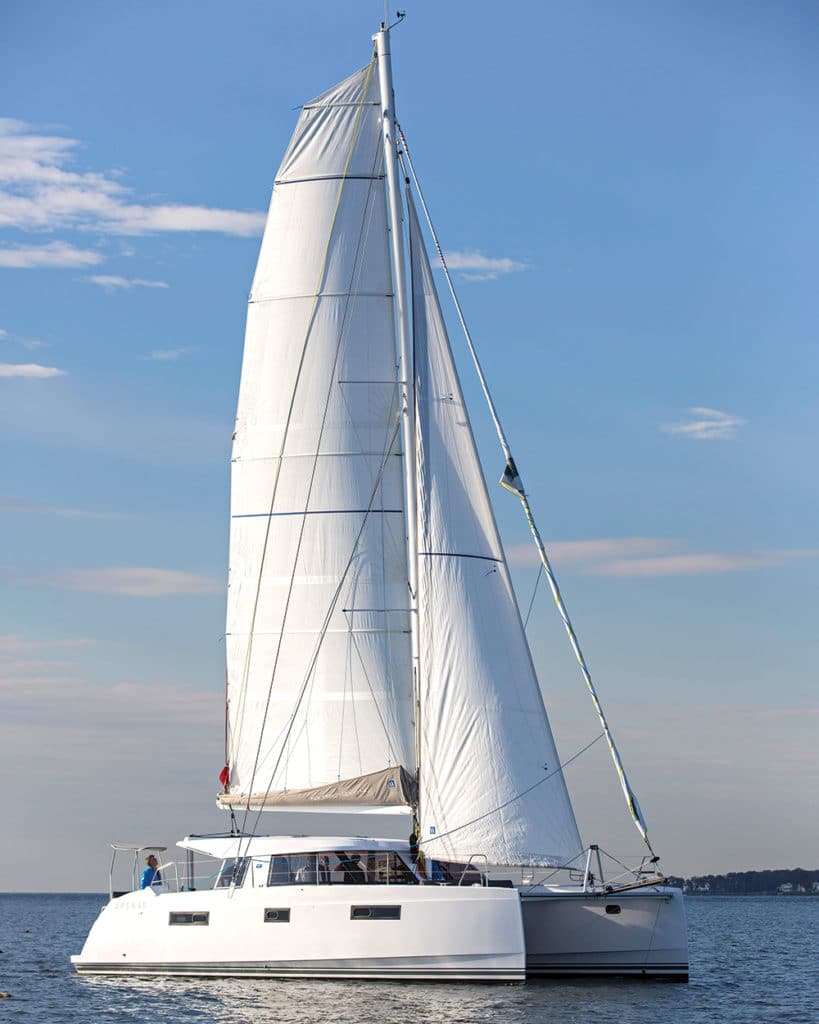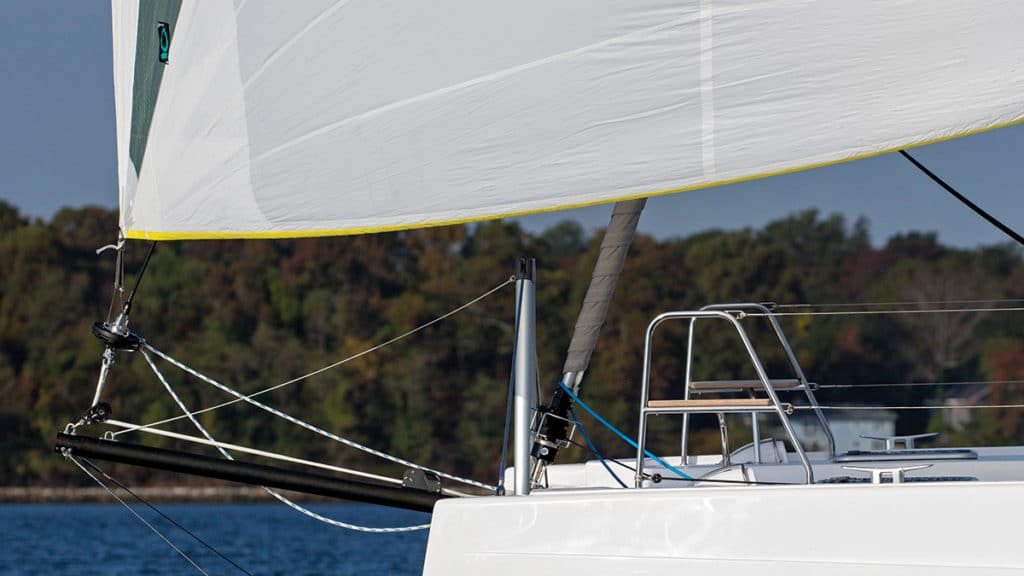
It was about midnight, and we were barreling along on a close reach through boisterous seas in a gusty 20-knot breeze. I was on watch aboard a Saba 50 catamaran, and while checking the sail trim, I couldn’t help but be in awe of the forces at play — particularly on the massive mainsail. It’s impressive.
With these forces, the sails aboard a modern cruising cat need to be up to snuff. If you’re in the market for new sails, what are the details that you should be looking for? I checked in with sailmakers who specialize in multihulls to find out what they would recommend for a midsize production cruising cat, such as a Leopard 44 or Lagoon 42.
Let’s start with the main. The mainsail is the driving sail aboard catamarans, and a backstayless rig, which you’ll find on most cats, allows for a large amount of roach. These massive sails have different requirements from their cousins aboard monohulls, which impacts what materials and techniques will be used to build the sail.
“Due to the higher sail loads, we would go up to a heavier weight of material than a similar-size monohull,” says Tim Yourieff, of Neil Pryde Sails. “Also, multihulls tend to have very swept-back spreaders and shrouds, which tend to chafe on the battens when the mainsail is eased when sailing downwind. It is very important to reinforce the batten pockets where they come in contact with the shrouds.”
Zach Mason, a multihull specialist for North Sails, adds, “I would recommend a high-roach full-batten mainsail for daysailing and cruising. Reefs should be appropriate for boat setup. If only two reefs can be easily set up, the second reef should be in the third-reef location, with the first reef splitting these.”
Looking to improve your speed, especially in light air? “For customers seeking more performance, we could build a square-top main,” says Mason. “But that requires additional hardware to lower and raise the gaff batten. It’s important to make sure that the existing hardware can be adapted or new hardware can be installed to make raising and lowering of the gaff batten easy. Overall though, square tops offer better sail shape and allow the top of the sail to twist off as a puff hits.” This unloads the sail, without someone having to immediately ease the mainsheet or traveler.
Which sailcloth you choose is highly dependent on your budget, cruising plans and how you sail. “Cross-cut Dacron still offers the best value in cost and longevity,” Yourieff says. “We recommend using a fairly balanced weave Dacron, with big yarns in both the warp and fill direction, especially if sailing in high-UV areas. The sails will last much longer.
“If the budget allows, then a performance upgrade would be to make triradial sails in either a cruise laminate or a warp-oriented Dacron, which is now also available. Triradial construction provides better shape-holding control as opposed to cross-cut construction because the fabric threads are more in line with the loads out of the corners of the sails. If sailing in high-humidity areas, we would recommend the warp-oriented Dacron over a cruise laminate because it is less likely to become mildewed. The upcharge for going to triradial over cross-cut is approximately 25 percent.”

If you have an eye on performance, and a larger sail budget, consider going with a more high-tech option. Mason recommends North’s line of 3Di sails, which are molded as one piece instead of stitched together. “With 3Di sails, we can align fibers in the sail in the exact load-bearing directions seen in square-top and high-roach sails. This is not achievable with paneled sails because there will still be high off-axis loads using paneled sailcloth.”

As with most things, the devil is in the details. For sailors coming from a mono-hull background, Mason points out some of the things to keep in mind when purchasing sails for a cruising multihull: “Due to the high righting moment, the sails should be overbuilt versus typical monohull sails. The base material might be 50 percent stronger than a monohull of the same size. Corner rings and webbings need to be upsized as well. Seaming in paneled sails needs heavier thread and more rows. Battens need to be stiffer and more durable. Do not skimp on battens, because the mainsails are heavy with a large roach that needs to be supported. Batten angles should be optimized for easy flaking, and square-top sails should have a detachable head carriage. Furthermore, we recommend chafe protection on batten pockets for shrouds and lazy jacks.”
For headsails, many cruising cats have self-tacking jibs, which are a good choice for boats with shorthanded crews, but at a cost of performance. These sails are typically tall and thin, and can develop too much twist at the top once the course sailed is past a close reach. Sometimes vertical battens are added to help this. As for a genoa, Mason recommends that “the sail be built as large as possible because most cruising boats are underpowered, but it should have a higher clew for good visibility.”
Both sailmakers suggested adding an off-wind sail, if the boat doesn’t have one already. Yourieff recommends a screacher set to fly on a low-stretch torque luff rope on a furler with a UV cover so it can be left hoisted and rolled while cruising. “This sail will add considerable performance to the boat in lighter winds and when sailing off the wind in heavier air.”

Mason adds that “nylon sails should not have UV covers because the material stretches at different rates, making for a poor-looking sail. If you require a UV cover to be left up and stored, the sail should be low-stretch or a laminate equivalent. If your boat does not have a bowsprit, we would recommend a free-flying G-2 gennaker that can be flown from centerline or from the windward hull to get lower angles.”
Whether your boat is a high-performance rocket or just retiring from charter duty, adding new sails will improve performance and make your cat or trimaran easier and more fun to sail.
Jennifer Brett is CW’s senior editor.








